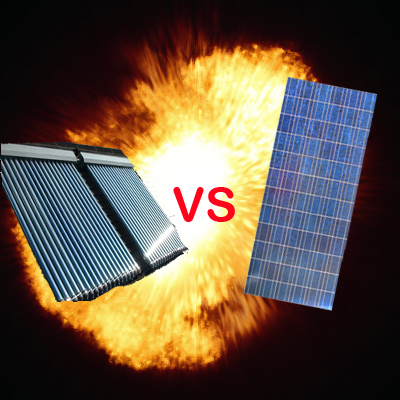
Is there competition within the solar industry, between photovoltaics and thermal technologies? Or is it more like one beast, with two heads, talking to itself? Perhaps that’s a bit farfetched. Let’s go with this: two friends, working toward the same end, who will have to learn to work together to achieve their goals.
First off, let’s clarify the difference between the two. Solar thermal captures the sun’s heat, which is then distributed through the home. Photovoltaic panels convert the sunlight directly to electricity and use it to power the home. Now, looking at the numbers, it would seem that solar thermal has the obvious advantage over solar PV, for a few reasons.
- Efficiency. Thermal solar collectors capture up to 70% of the sun’s heat for use in the home. Solar PV panels convert, on average, only 12% of sunlight into electricity.
- Size. A rule of thumb for solar energy; there is 1kW of solar energy available for every square meter. This translates into 3400 BTU/hr/square meter. Now, at 70% efficiency, you only need approximately 42 sq. meters of collectors to produce 100,000 BTU/hr. This is the equivalent of the heat generated by a typical gas furnace.
- Cost. Thus, you would need less space and less solar thermal collectors, which are inherently much cheaper than PV panels anyway, to fulfill your heating needs. Here you have a scenario in which you have a system that is 6 times more efficient and 5 times cheaper than its rival.
So why doesn’t solar thermal dominate?
Give me one good reason, you might say, why SpongeBob SquarePants isn’t installing a solar thermal system on top of his pineapple. Here are a couple:
- Storage. Heat is very difficult to store without some sort of thermal mass. Thermal mass walls or floors are a common feature of passive solar homes. However, it is exceedingly difficult to retrofit such a wall after the home is built. So retrofit systems must be active systems and will require large storage tanks which can be difficult to fit to your exact needs.
- Year-round Use. Perhaps the biggest advantage for solar PV is that is remains relevant throughout the year. Thermal space heating systems can sit unused for up to six months during the summer. While PV continues to provide usable electricity year round.
For these reasons, solar PV still dominates America’s solar rooftops. However, solar thermal hot water systems are an excellent, very cost-effective, way to supplement energy bills. Water heating, after all, is the second biggest user of energy in the home; behind space heating. Not only that, there have also been recent innovations in solar thermal.
Links:
> Thermal space heating systems can sit unused for up to six months during the summer.
This is why it would be nice to see progress in small scale absorption chillers.
Thermal solar dominates here in Canada. It’s used for domestic hot water which has a fairly constant demand year round.
Yes! Keeping in mind the drastic environmental changes and rising fuel prices going Solar is one option open to all at minimal investments. The Solar Water heating systems are so easy to install and most of them come in a Do-it Yourself kit, With the technological advancement the once heavy, bulky hard to move panels are now available widely in light weight easy to carry by one personal only packages. The advancement in technology is not only limited to light weight, but for those concern about the asthetics of the panels, the good news is that the panels are now available with a variety of teim colors to choose from and can be easily matched to your roof. Saving about $25.oo on ones electricity bill on a residence of 4. We all use hot water, as one of our basic needs and what can be a better way, than helping our environment, saving our resources and ourself’s some money other than by investing in a Solar Water Heating System.
There are a couple useful websites I’m aware off, that I would like to share with you
1. http://www.dsireusa.org – is a comprehensive source of information on state, local
, utility ans federal incentives that promote renewable engery ans energy efficieny.
2. http://www.powerpartnerssolar.com – one of the many manufacturers of certified Solar Water Heating Systems available. One place I saw the light weight panels and trim color options I was mentioning earlier.
Lastly, the local utilites in some areas also provide additional rebates and incentives for adding a Solar Water Heating Sytem to your exisitng water tank.
Keep the look out on. Feel Good and save- money for you, environment for us.
solar thermal is catching on in the US and Spain in particular with the large scale power plants. Spain has plans to build up to 60 plants.
oh and the US has the largest solar thermal plant in the world in the Mojave desert
Thin Film photo voltaics are an innovation in PV fabrication that have the potential of competiting with Thermal on the intial expense.
Perhaps a hybrid panel might make sense as an idea.
Amazing information!!!Solar power is essential to save our electricity.The above information is useful for me to develop a web page aboutâ€SOLAR ENERGY AND SOLAR POWERâ€
Hi there
we want 100pcs of 75w and 100pcs of 80w so please send me the profomal invoice if available on stock cif uganda by air cargo frieght to Entebbe air port kampala-uganda
Waiting for you shortly
Best regards
Judy(purchasing manager)
Ralablanc co ltd
Plot 2 south st
Mabilizi building
Kampala/uganda
Tel +256 712273466
Fax 256 414236781
Hi thanks for the video. And I would like to have the Samo pump wthiout any other modification. My Q is where I can get one like? that please. thank you.
Hi thanks for the video. And I would like to have the Samo pump wthiout any other modification. My Q is where I can get one like? that please. thank you.